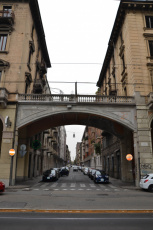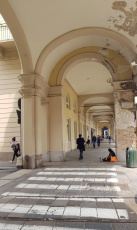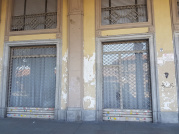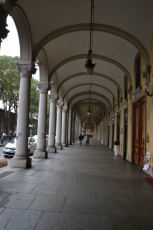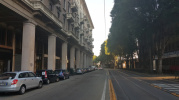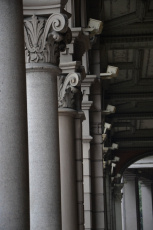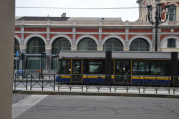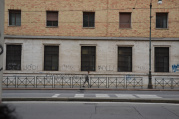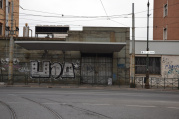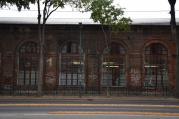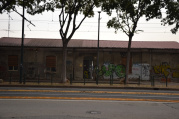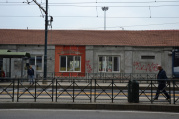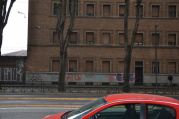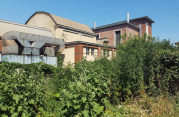Archive
CALL FOR CONCEPT // STEP 1 2018
The arcades design, design for the arcades. Via Sacchi in Torino, an experience of urban regeneration.
The Call for Concept asked the students to outline a concept of approach to the re-generation of "via Sacchi”, as an area of creativity, inclusiveness and sustainability.
Today the street is characterized by three paths: the west porticoed side which features via Sacchi, the middle, a road travelled by public and private transportation and the east side barrier to the railway, where there is a pedestrian and cycle path. The northern edge consists of the facing towards the station central square (p.za Carlo Felice). The south edge (on its east side) has a narrow band in conditions of abandonment (below the c.so Sommeiller overpass).
The arcades of via Sacchi are part of the wider historical path of Turin’s arcades (12 km). Due to the commercial decrease, even the arcades on the opposite side of the station, corresponding to Via Nizza, suffer a significant level of urban degradation.
The Call for Concept has required, as a contribution, a design concept (not a project in detail) upon one or more of the axes indicated for Via Sacchi, with the aim of triggering processes of re-generation and attraction for this area.
Identifying:
functions and ways of use of the streets: encouraging the establishment of new creative activities and proposing ways to communicate them (i.e temporary shops and showrooms, venues for cultural associations and social, spaces for information point and collective interest services, co-working areas, spaces for craft activities and makers); increase physical access for all in safe conditions (public transportation stops, cycle path and pedestrian on the east side, pedestrian connection between via Sacchi and via Nizza); enhancing the paths on the railway side (spaces for social activities, relational and communicational spaces, walls, bus stops).
Involving:
the components of the urban scene, respecting the historical values: arcades (i.e. architectural elements, shop windows, signs, sunshades, inter-pillar windows, furnishing and communication equipment); the middle road (i.e. pedestrian barriers, sidewalks, public transportation stops); railway side (i.e. tree-lined and low-rise, road signage, furniture and communication equipment).
Developing:
analogical and/or digital solutions for the use and communication of paths; permanent or temporary equipment systems; light & soundscape and communication tools.
BEST PROJECT SELECTION
V.S.R. Via Sacchi Regeneration
by Miriam Sandalo, Piero Tarozzo (Polytechnic of Turin).
Motivation: Able to outline a concept of approach to the functional and identity re-generation of via Sacchi, understood as a portico axis of creativity and design, through local brand factors that can connote future reuse, in respect of historical values
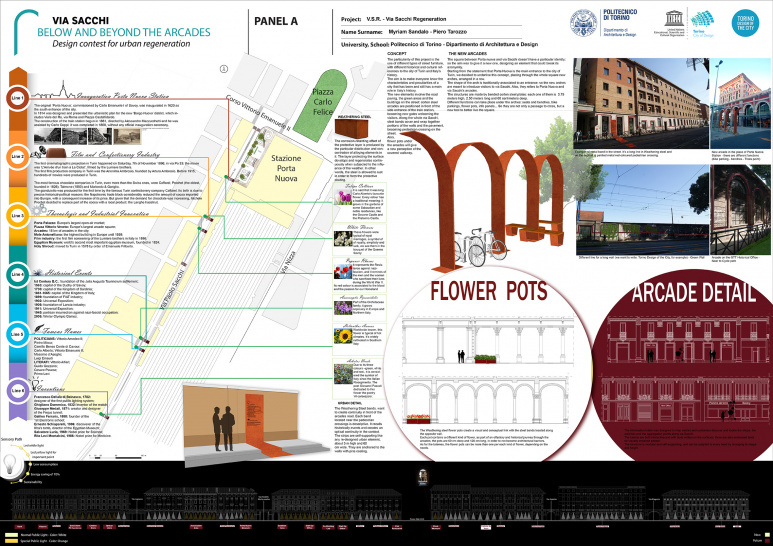
LIVING LAB // STEP 2
Seminars, co-design workshops, meetings.
GOLAS
The Living Lab 2017-2019 is aimed at the comparison, exploration, experimentation and evaluation of innovative ideas.
It is aimed at investigating, with experts, administrators, selected citizens and students, the scenarios for the city of creativity, sustainability and inclusion, regarding new functions and ways of use, involving different components of the urban scene and developing solutions for the reuse of commercial ground floors, for the usability and quality of public spaces and for communication, with multimedia equipment and applications.
The methods of transforming places and spaces can serve as a model that can be adapted to other sections of the portico system in Turin or to peripheral areas experiencing similar conditions of commercial decline and a consequent reduction in attractiveness.
PARTICIPANTS
During the Living Lab 2019, the selected students from the Degree and Master's Degree Courses of Colleges of Architecture and Design will participate in the laboratory activities, in September, through meetings with the city stakeholders (citizens, city users, associations, companies, public administrations ...) and seminars with qualified professionals and scholars.
The Living Lab provides for the participation of undergraduates, recent graduates, post-graduates, graduate students and professors from the Polytechnic of Turin and the University of Bologna, partner of the initiative.
The partnership of the University of Bologna is in relation to the comparability of the porticoed context, currently subject to application to Word Heritage UNESCO, and to research and urban regeneration initiatives, such as the European project ROCKBologna - Regeneration and Optimization of Cultural heritage in creative and Knowledge cities (May 2017 - May 2020) which also involves the City of Turin.
The activities of LivingLab are open to citizens, city users, associations and local businesses.
PREPARATORY STEPS
The preparatory phase included a first seminar (October, 10th 2017), structured as a participatory design debate, with the participation of experts, local administration’s officials, journalists as well as students and citizens (about 80 participants).
The complexity of the context (urban landscape, mobility and transport, trade, culture, architecture, urban history, memories ...) and the number of the involved people is aimed at moving the design to an inclusive community team.
The result of discussions proposed early ideas of urban space and reuse to be offered to students and designers as a ground to grow a new mix of functionality and visual layout.
The "Service design" for regeneration is the highlighted possible approach, understood as a mediator of knowledge, skills and as a facilitator of communication.
As part of the "Torino city of design", the results were presented to citizens in the # SACCHI56 info-point coordinated by the Fondazione Contrada Torino (20-30 October 2017) and presented at the International Seminar “Design of the City: Design for Citizens”, (October, 12th 2017, Aula Magna Cavallerizza Reale, Turin, Citizens design their city, Report on Via Sacchi Living-Lab).
Contributions to the Committee “Rilanciamo Via Sacchi” and the public assembly (16 April 2018).
The press conference in "Torino Design for the City" (12 October 2018) presented the state of the art and the winners of the "Call of Concept".
The topic is the subject of the awarding of the “Borsa Bando Talenti della Società Civile” 2018, Goria Foundation for the project: "Urban regeneration: the public space and the arcade system of via Sacchi in Turin, in a state of commercial decrease. Analysis of international case studies and methodological approaches to image reconstruction, design, cultural and functional recovery processes in social innovation "(Raffaele Falabella, February 2019).
The Teaching Atelier "Via Sacchi regeneration" in Building in the Building, Degree in Architecture, Polytechnic of Turin (professors Carlo Deregibus and Rossella Maspoli), outlined scenarios of urban regeneration of the east side of via Sacchi, in collaboration with FS Sistemi Urbani, Ferservizi SpA - Turin office, Committee Rilanciamo Via Sacchi, Fondazione Contrada Torino (March - June 2019).
TOPICS
Today the via Sacchi is characterized by different architectures and three paths: the west porticoed side which features the middle, with a continuous architecture of high value, but which is subject to degradation in the portico and commercial desertification to the floor ground; a road traveled by public and private transportation and the east side barrier to the railway, where there is a pedestrian and cycle path, with low environmental quality and use of public space and discontinuous buildings, with degraded industrial service of varying value from the late 19th and early 20th centuries to the south of the monumental railway station and inhomogeneous multi-storey buildings from the second half of the 1900s. The northern edge consists of the facing towards the station central square (p.za Carlo Felice). The south edge (on its east side) has a narrow band in conditions of abandonment (below the c.so Sommeiller overpass).
Since some years, both these areas are the object of social attention and redevelopment interventions by different players (city administration, neighborhood and sector associations, architectural heritage superintendents, citizens), which have tried to promote actions for the redevelopment of the built environment, in favour of the relocation of commerce and of a social nature. Today these attentions begin to bear fruit, through the formula of the Living Lab (Participated Laboratory). The needs of the single public spaces will be faced, sharing ideas for punctual and even small-scale actions, so-called acupuncture, integrated and achievable with resources limited, requiring great creativity.
The first phase of comparison highlighted different thematic approaches, included in a wider and systemic view, then converging on 10 themes: from the possible connections between the two districts through the Station to the physical accessibility of structures and infrastructures; from the reuse of railway walls to the testing of bus stops with the offer of new functions; from attention to historic and current urban furnishings (tents, shop windows, signs) to the recovery of residual areas.
10 themes, 100 ideas for via Sacchi:
ABANDONED GREEN: what future?
BY BIKE: but on a safe and signposted track
WELCOME: the discomfort with a stimulating environment
SHOWCASES: they are attractive, if they expose and communicate
THE WALLS of the railway are spaces open to creativity, awaiting transformation
WAITING FOR THE BUS: socializing, reading, inquiring, playing
URBAN FURNITURE: enhancing the historical one, coordinating the added one
ATTENTION STEP: make shops accessible to everyone
CROSS: easy and safe
IN THE STATION: re-open the covered passage/walk

The contextual themes open to different fields of study for the Living Lab:
Co-design & design thinking
A participatory approach, involving citizens, operators, experts, students to bring about solutions or opportunities for change. Observe, develop points of view, explore different solutions, test the feasibility with stakeholders ...
Arcades & Turin experiences
The arcades of Turin compared to those of Bologna, UNESCO World Heritage candidates, the prospect is to enhance the heritage and innovation of public space and activities. Recent experiences are the "Portici di Torino" project of the Contrada Foundation, the activities of the "Rilanciamo via Sacchi" association and the "Turin public space" for green with volunteers.
Furthermore, the results of the “Via Sacchi Regeneration” Didactic Atelier, Degree in Architecture, Polytechnic of Turin (AA 2018-9), open to scenarios of change, which bring into play the potential railway disposal and the opening of the east side of via Sacchi, beyond the northern area of the station.
Communication & smart street
Physical factors (vertical and horizontal signage, design on shop windows) and digital factors (web platforms and social networks, Internet of Things, digital equipment, light applications, sound and multimedia tools, flow and safety control systems) for communication and fruition are essential to implement for the relaunch of the route.
The new technologies are in the direction of the "smile city", a word that refers to the association between "smart" and "social", in favour of accessibility and inclusiveness.
Creative district & temporary reuse
The retail and neighbourhood trade crisis opens up to outline the prospect of a district dedicated to the creative industry, to new functions and use modes such as: temporary stores, temporary showrooms and galleries, innovative commercial activities and e-commerce, offices of associations, services for social inclusion, co-working and smart-working activities, start-ups, production and exhibition centres of artisans and digital makers.
Retail policies & common ground
Against shrinkage, urban contraction and commercial desertification and for the redevelopment of public space, intervention strategies based on the support to the establishment of new enterprises (in synergy between public, private, associations), on the animation of the portico as space are required widespread exhibition, on the assignment to the care of citizens and associations of parts of the public space, favoring the initiative of different subjects that contribute, with their skills and competences, to the resolution of problems that concern the community.
Accessibility and furniture design & spatial and environmental design
The deepening on the redesign of public space concerns the redefinition of its elements, the guarantee of accessibility of the ground floor to users with different abilities and also the rethinking of crossings, public transport stops, equipped pedestrian and cycle paths, the endowment of green spaces and equipment for relaxation - play - fitness in the public space, the enhancement interventions of the curtains built on the east side. The reference is to the 10 themes, 100 ideas for via Sacchi. Furthermore, environmental aspects must be addressed: day and night lighting, sunshine control and heat island effect, acoustic disturbance.
Via Sacchi Past and Present - EN ![]() (18.92 MB)
(18.92 MB)
ARCHIVIO_via Sacchi. Future_18.7.19agg.pdf ![]() (6.07 MB)
(6.07 MB)
Via Sacchi Future - EN ![]() (5.30 MB)
(5.30 MB)
DWG Sottoportico Governolo_Valeggio ![]() (598.89 kB)
(598.89 kB)
DWG Sottoportico Legnano_Montevecchio ![]() (995.39 kB)
(995.39 kB)
DWG Sottoportico Pastrengo_Legnano ![]() (975.59 kB)
(975.59 kB)
DWG Via Sacchi isolati 1-6 ![]() (2.62 MB)
(2.62 MB)

